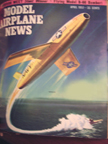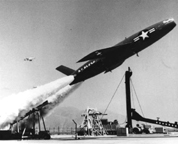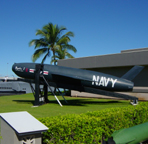April, 1957

Chance-Vought SSM-N-8 "Regulus"
Model Airplane News Cover Art for April, 1957
by Jo Kotula
Click to Enlarge
The SSM-N-8A Regulus was a nuclear deterrent cruise missile employed by the United States Navy from 1955 to 1964.



Photos of the Chance-Vought SSM-N-8 "Regulus"
Click to Enlarge
Work on guided missiles was not limited to Germany and its V-1 and V-2. As early as October 1943, Chance Vought Aircraft Company was developing a 300-mile range missile that would carry a 4,000-pound warhead. Propulsion and guidance were major problems and the war ended without a satisfactory result. In 1947, with a fresh infusion of Nazi scientists, the Army moved the program to Martin Aircraft Company with contract for a turbojet powered subsonic missile called the >Matador.
The politics of the immediate postwar period were unification and budget cutting. Because Americans thought that all problems could be solved by the Atomic Bomb (which the US had a monopoly until 1949...). Thus, you didn't need a Navy or an Infantry -- just airplanes to deliver the Bomb. In fact, the supercarrier USS United States had been cancelled to pay for the B-36 program. The famous Admiral Arleigh Burke was the Chief of Naval Operations and took the threat of dissolving the Navy very seriously. he wanted the Navy into the Nuclear business as soon as possible. The Navy saw Matador as a threatand, within days, started a development program for a missile that could be launched from a submarine. This was the beginning of the "Regulus" missile which was designed to carry a 3,000-pound warhead, for500 nautical miles at Mach 0.85, and hit within 2.5 nautical miles of its target.
Regulus was 30 feet long 4 feet in diameter with 10 foot wingspan. After launch, it would be guided toward its target by two control stations. (Later, with the Trounce system, one submarine could guide it).
Since we had only a finite number of Nazi scientists, it is no wonder that Regulus and Matador were quite similar to each other and to the V-1. They used the same engine, looked alike and had nearly identical performance, schedules, and costs. Under pressure to reduce defense spending, the United States Department of Defense ordered the Navy to determine if Matador could be adapted for their use. The Navy concluded that the Navy's Regulus could perform the Navy mission better since it required only two guidance stations while Matador required three. It could also be launched quicker, as Matador's boosters had to be fitted while the missile was on the launcher while Regulus was stowed with its boosters attached. When Chance Vought built a recoverable version of the missile, it was argued that although the first cost of a Regulus test vehicle greater than Matador, Regulus was cheaper to use over a series of tests. The Navy program continued, and the first Regulus flew in March 1951.
The first launch from a submarine occurred in July 1953 from the deck of USS Tunny (SSG-282), a World War II fleet boat. Tunny and her sister boat USS Barbero (SSG-317) were the United States's first nuclear deterrent patrol submarines. They were joined in 1958 by two purpose built Regulus submarines, USS Grayback (SSG-574), USS Growler (SSG-577), and, later, by the nuclear powered USS Halibut (SSGN-587). So that no target would be left uncovered, four Regulus missiles had to be at sea at any given time. Thus, Barbero and Tunny, each of which carried two Regulus missiles, patrolled simultaneously. Growler and Grayback, with four missiles, or Halibut, with five, could patrol alone. These five submarines made 40 Regulus strategic deterrent patrols between October 1959 and July 1964, when they were relieved by the George Washington class submarines carrying the Polaris missile system. Regulus was also deployed by the US Navy on cruisers and aircraft carriers. In order to use the stock of missiles, the Navy investigated the possibility of converting the Regulus into an unmanned aerial vehicle: missiles would be launched from cruisers or submarines, and once in flight, guided to their targets by carrier-based pilots with remote control equipment. This program was superseded by other technological developments.
Here is a video compilation of nuclear guided missiles of the 1950s. The Chance-Vought SSM-N-8 "Regulus" makes a brief appearance:
Click Here for more information about the Chance-Vought SSM-N-8 "Regulus".

Click to go back and select another cover.
Counter for the Entire Site (not just this page..)
Home | About Lindy | Last Week's Reviews | Upcoming Events | 1940s Collecibles
The Guide - Establishments - Travel - Accessories
Music | Links | Photo Gallery | Extras | Contact